For the winter of 1925-26, Canadian Pacific decided to begin its round-the-world tour in early December rather than mid-January. It may have been reluctant to do this in 1924 and 1925 because it feared some potential passengers would not want to be away from home on Christmas. But the change in schedule was a better fit with the months that the St. Lawrence Seaway was too iced up for service to Quebec, namely December through April.
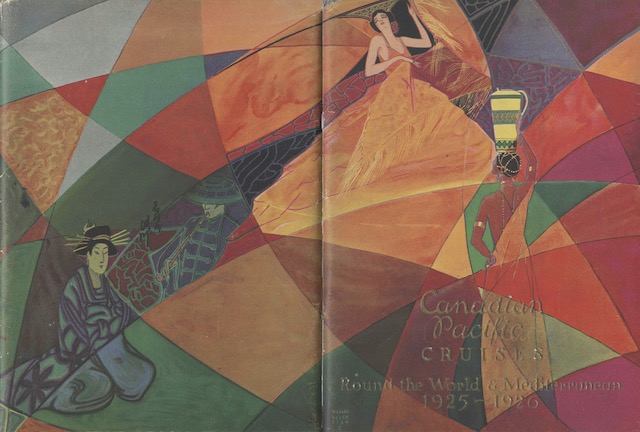 Click image to view and download a PDF of this booklet from the University of British Columbia Chung collection.
Click image to view and download a PDF of this booklet from the University of British Columbia Chung collection.
The cover art on the above booklet is signed Richard Allen Fish. Most on-line descriptions of the booklet assume he did all of the interior art as well, but most of the interior art can also be found in the 1925 booklet, suggesting it was really done by Holling Holling. I can’t find much information about Fish on line other than that he was born in 1900 — the same year as Holling — and worked as an artist in Chicago, Detroit, and New York.
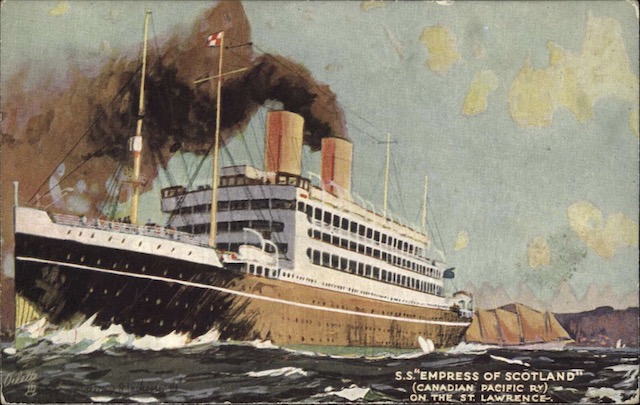
The Empress of Scotland as it would have appeared in 1925-26. Click image to download a 200-KB PDF of this postcard.
This ship for this cruise was the Empress of Scotland, which had been built in 1905 for the Hamburg-America Line. It was taken as a part of war reparations and sold to Canadian Pacific. CP refitted it for 459 first-class passengers, 478 second class, and 960 third class. Except for a few second-class cabins for servants, only the first-class cabins would be used on this cruise.
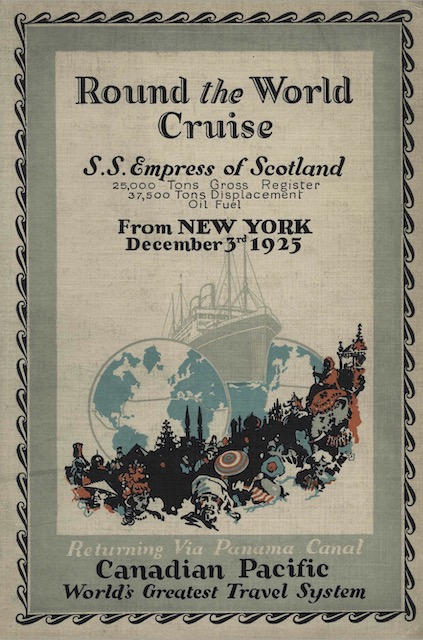 Click image to view and download a PDF of this booklet from the University of British Columbia Chung collection.
Click image to view and download a PDF of this booklet from the University of British Columbia Chung collection.
Other than the change of dates, the main change in the itinerary was that the 1925-26 tour skipped Victoria, Vancouver and San Francisco, going instead from Hawaii to Los Angeles. This saved 1,200 miles and at least 3-1/2 days. The total cruise was cut from 130 to 129 days, leaving a few extra days to spend touring places such as Egypt and Japan.
The basic fare for this cruise was $1,750, or $250 less than the 1925 cruise. That’s quite a savings for a trip that was only one day shorter. Except for Victoria and Vancouver, and the substitution of a drive through Los Angeles for one through San Francisco, this fare includes all the same excursions that were provided in 1925.
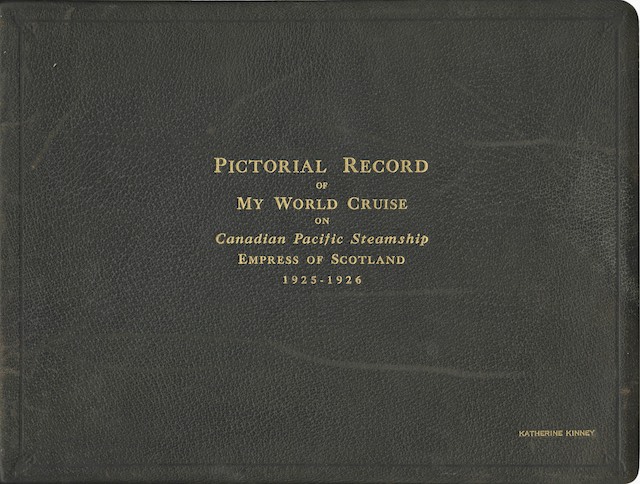 Click image to view and download a PDF of this booklet from the University of British Columbia Chung collection.
Click image to view and download a PDF of this booklet from the University of British Columbia Chung collection.
A passenger named Katherine (“Kay”) Kinney took or collected more than 225 photos of the trip and placed them in this album. Some of the photos are signed, presumably by the person in the photo, and some of those are dated well before the cruise was finished, suggesting that the ship had an on-board darkroom. Kinney, who was born in Massachusetts on Christmas Day in 1900, took the trip with her aunt, Ida Kinney, who was 22 years older. The fifth photo in the album shows Kay Kinney seated next to a standing woman, presumably Ida.
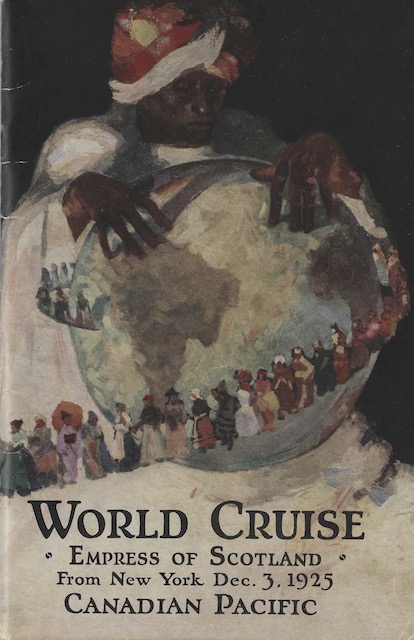 Click image to view and download a PDF of this booklet from the University of British Columbia Chung collection.
Click image to view and download a PDF of this booklet from the University of British Columbia Chung collection.
Kay Kinney also saved this list of passengers who took the cruise. She must have been a vivacious companion as she has made notes of addresses and home towns of dozens of the passengers. According to the list, the ship carried 514 passengers plus 12 servants. Ms. Kinney scratched out the names of a few passengers, which may mean they didn’t go or it that she didn’t like them.
She did write the address for Harry Pollard, who is listed both as a passenger and as cruise staff as “press photographer.” Pollard lived in Calgary and took the photos of Blackfeet Indians that were used on CP’s Buffalo Child Long Lance menus. Pollard went on 14 Canadian Pacific world cruises.
Kay Kinney would go on to marry a New York City man named John Hecox in 1932. He was two years younger than her, but that wasn’t enough as he died in 1963 whereas she lived until 1991, passing away just 11 days shy of her 91st birthday.
Of the other passengers on board, two that jump out at me are Sir Arthur Mayo-Robinson and Monongahela de Beaujeu (misspelled de Beaujeau in the passenger list). Mayo-Robinson (1853-1933) was knighted in 1908 for his pioneering work in abdominal surgery. He received more recognition for serving in the Army Medical Service in the Great War.
de Beaujeu’s name struck me because I am familiar with the Monongahela River and Monongahela National Forest in West Virginia. How does someone from Quebec, which was apparently the French-speaking de Beaujeu’s home, get a first name like that? It turns out that he wrote a biography of an ancestor who fought on the French side in the French-and-Indian War of the early 1750s.
The ancestor, Daniel Liénard de Beaujeu, was killed in the 1755 Battle of the Monongahela River, but because his soldiers (including many Indians) adopted his tactics, the French prevailed over British General Braddock and a colonel named George Washington. This made de Beaujeu the “hero of the Monongahela.” So the passenger on this cruise was named after the battle that killed his ancestor.
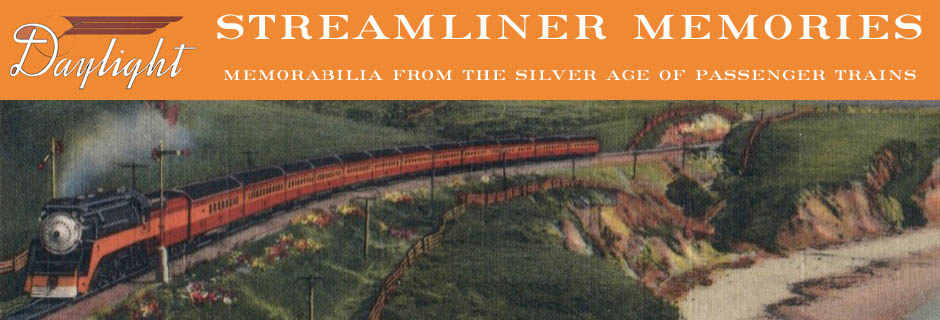
May I respectfully suggest that the use of “Seaway” above is incorrect as the locks etc. that made it possible did not open until 1959. Therefore, “River” is more appropriate, in my opinion, as the ships never ventured further up that river than Montreal where it did, indeed, freeze in the time period mentioned.